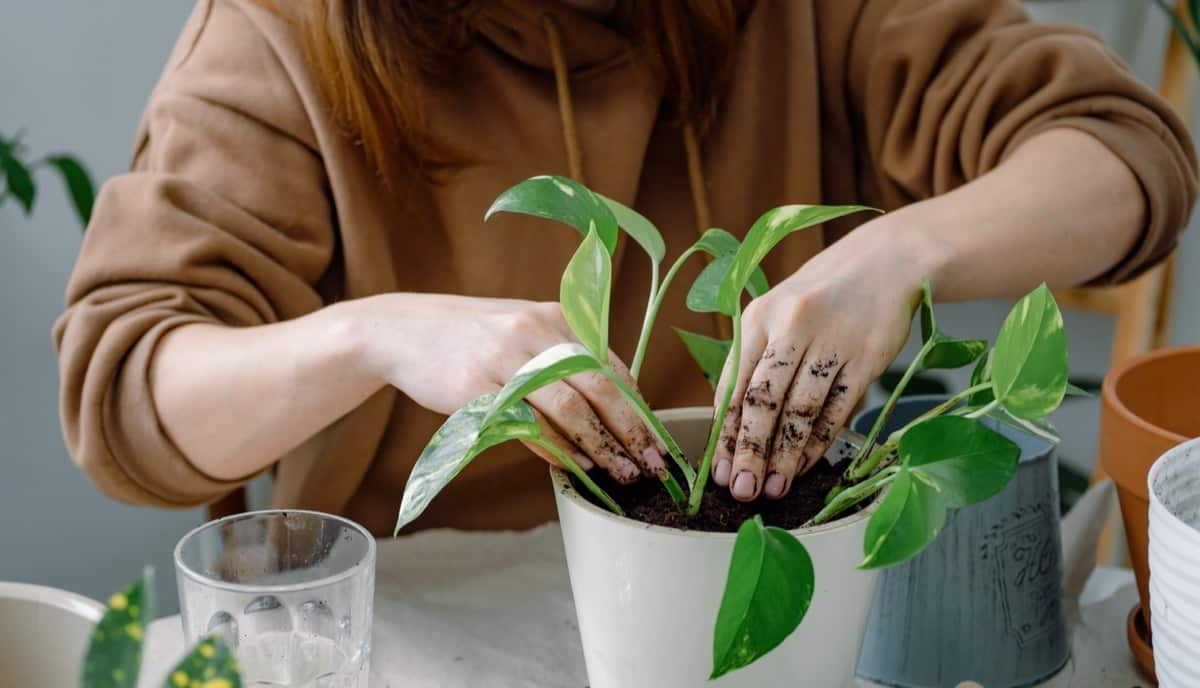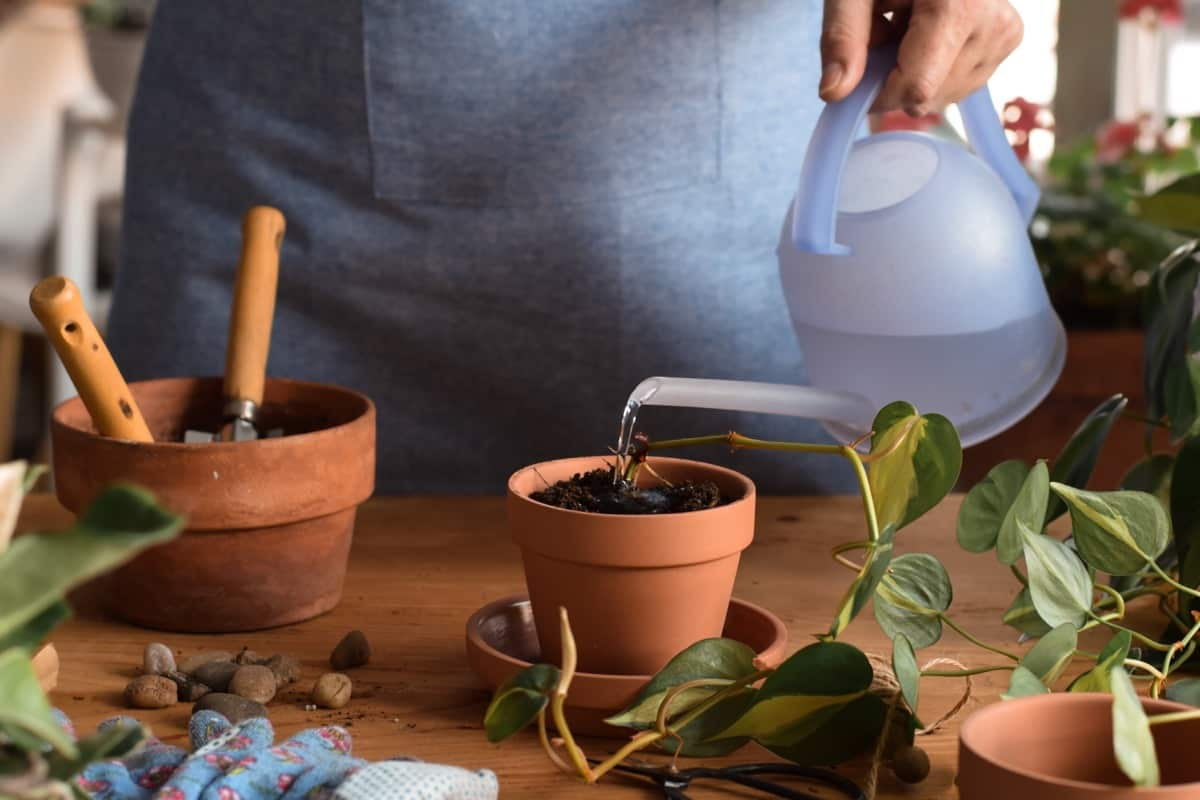Devil’s Ivy is a popular houseplant with beautiful trailing vines that can bring life and greenery to any space. With its heart-shaped leaves thrive in low light conditions, this trailing beauty is perfect for any indoor space. Not only does it bring a sense of serenity to your surroundings, but it also requires minimal watering. Pothos plants are not only beautiful but also very easy to propagate indoors. Let’s check out more information on how to propagate pothos from leaf cuttings below.

Information About Growing Pothos
| Common Name | Pothos, Golden Pothos, Devil’s Vine, Devil’s Ivy |
| Botanical Name | Epipremnum aureum |
| Family | Araceae |
| Plant Type | Vine |
| Sun Exposure | Full sun, partial shade |
| Soil Type | Moist but well-drained |
| Soil pH | Neutral to slightly acidic |
In case you missed it: Common Pothos/Money Plant Problems: How to Fix Them, Solutions, and Treatment

Step-by-Step Guide on How to Propagate Pothos Plants Indoors
- Firstly, gather your supplies. You will need sharp scissors, clean water, and a small jar filled with water or potting soil for planting.
- Next, choose the method of propagation that works best for you. Pothos can be propagated through leaf cuttings, stem cuttings, or water.
- Select a healthy leaf with at least three or four full leaves attached if using leaf cuttings. Cut the leaf just below where it meets the stem.
- Select a healthy vine with several nodes present for stem cuttings. Nodes are the points along the vine where new growth emerges. Make sure to leave at least two nodes intact on your cutting.
- Once your cutting is ready, please place it in a clean water jar or directly into moist potting soil. If using water, ensure that at least one node is submerged for roots to develop.
- Keep your cutting in bright indirect light and maintain consistent moisture levels throughout the rooting process. Once roots have formed and are well-established (at least an inch long), you can transplant your new Pothos plant into its container filled with fresh potting soil.
Easy Ways to Propagate Pothos from Stem Cuttings
To start, choose a healthy vine from your Pothos plant. Look for a section of stem at least four inches long with several leaves attached. Can I Grow Pothos from Cuttings? Pothos plants are incredibly easy to propagate from cuttings, making them a popular choice for beginner gardeners. Make a clean cut below a leaf node using clean pruning shears or sharp scissors. Once you have your cutting, remove any leaves on the bottom inch or two of the stems. These lower leaves will be buried in soil or placed in water, so it’s important to remove them to avoid rotting.
In case you missed it: Growing Hydroponic Money Plant (Devil’s Ivy/Pothos)

Next, decide whether to root your cutting in water or soil. Do Pothos cuttings grow faster in water or soil? Both methods can be successful in propagating Pothos. Some gardeners may find that their cuttings thrive better in one medium than another, while others may see similar success regardless of the propagation method.
Whether you choose water or soil for propagating your Pothos cuttings will depend on various factors such as your preferences, environmental conditions, and how well your plants respond to each method. If using water propagation, place the cutting in a jar filled with filtered water and set it in a bright location. For those who prefer soil propagation, fill a small pot with potting mix and gently insert the cutting into the soil. Make sure that at least one node is buried beneath the surface.
Where to cut Pothos to propagate in water? When it comes to water propagation, snip off a healthy section of the vine just below a leaf node and place it in a water-filled jar. With time and patience (typically about 4-6 weeks), roots will begin forming on your Pothos cutting. Once these roots are well-established (gently tug on them if they offer resistance), you can leave your new plant in its current container or transfer it into its pot.
Tips and Tricks for Propagating Pothos Vines in a Jar of Water
Choose a clear glass jar or container, allowing plenty of light to reach the cutting. Pothos loves bright indirect light, so placing it near a window or under a grow light will facilitate healthy growth. Next, ensure your cutting has at least three or four leaves and a node. The node is where new roots will develop. Remove any leaves that would be submerged in water as they may rot.
In case you missed it: Best Fertilizer for Eddoe/Taro Root Plants in Pots: Organic, Slow-release, Liquid, and Natural

Once your cutting is ready, fill the jar with fresh room temperature water, ensuring the nodes are fully submerged while leaving the leaves above water level. Change the water every few days to prevent stagnation and bacterial growth. This helps keep your cuttings healthy and encourages root development. Patience is key when propagating Pothos in water. Roots can take several weeks to form, so don’t be discouraged if you don’t see immediate results. Watch for tiny white roots emerging from the nodes, indicating successful propagation.
How to Propagate Pothos Plants Using Rooting Hormone
Firstly, gather your supplies: a clean pair of pruning shears, a container with water, rooting hormone powder or gel, and small pots filled with well-draining soil. Next, select a healthy stem cutting from your Pothos plant. Make sure it has at least three or four full leaves and is about four inches long. Use the pruning shears to make a clean cut below a leaf node. Dip the cut end of the stem into the rooting hormone powder or gel, ensuring it is fully coated. Shake off any excess.
In case you missed it: Best Fertilizers for Swiss Chard Plants in Pots: Organic, Slow-Release, Liquid, and Natural

With time and care, you’ll see new roots forming on your Pothos cutting. Once these roots have established themselves (usually within 4-6 weeks), you can transplant them into their pots filled with well-draining soil mix.
How to Propagate Pothos from Leaf Cuttings to New Plants
To start, choose a healthy and mature Pothos leaf. Make sure it has at least three or four full leaves for the best chances of success. Where to cut Pothos to propagate it? Using clean and sharp scissors, cut the leaf right below a leaf node and where the leaf meets the stem. This is where roots will eventually form.
In case you missed it: Stylish DIY Plant Trellis for Pots

Once you have your cutting, please place it in water or soil. If you choose water propagation, ensure only the stem is submerged while keeping the leaf above water. Change the water every few days to prevent rotting. If you prefer soil propagation, insert the stem into moist potting soil and lightly press it down. Keep the soil consistently moist. Over time, tiny roots will grow from the cut end of your Pothos cutting.
Be patient with this process, as roots can take several weeks to develop fully. Once your cutting has established strong roots, it’s ready for transplanting into its pot with well-draining soil and proper sunlight conditions. By propagating Pothos from leaf cuttings, you can expand your plants easily and enjoy lush green foliage throughout your home.
Pothos Propagation Time Lapse: How Long Does It Take to Propagate Pothos?
The Pothos cutting typically takes 4-6 weeks to develop roots in the soil. During this time-lapse period, ensure the soil remains moist but not soggy. Too much water to the plant can lead to rotting roots and hinder growth.
In case you missed it: How to Grow Banana Peppers from Seed in Pots or Ground

Conclusion
Pothos, also known as Devil’s Ivy, is a popular houseplant loved for its vibrant foliage and easy-care requirements. Propagating Pothos cuttings in water is one of the easiest and most popular methods to grow new plants.
- How to Grow Hibiscus from Flower
- Plantation Ideas for Home Decoration: A Beginners Guide
- Flower Garden Designs and Layouts for Beginners
- Planting and Spacing Techniques in Papaya: A Beginner’s Guide
- Growing Gold: Essential Techniques for Planting Pineapples
- How to Make Kalanchoe Plant Bushy: Home Remedies and Solutions
- 11 Reasons Why Your Gardenia is Not Blooming: Home Remedies and Solutions
- Eco Elegance: The Guide to Designing a Drought-Tolerant Landscape
- Gardening on a Slope: Strategies for Hillside Landscaping
- Nourish and Flourish: Top Organic Mulches for Thriving House Plants
- Everything You Want to Know about Indian Mogra Flower: Discover Uses and Growing
- Green Thumb Success: Expert Tips for Cultivating Greenhouse Pumpkins All Year Round
- Maximize Growth & Flavor: The Ultimate Guide to Companion Planting in Herb Gardens
- How to Control Rhododendron Problems Naturally: Home Remedies and Organic Ways to Fix Them
- Natural Magic: The Remarkable Benefits of Cinnamon for Plants
- Best Steps to Revive Dying Tulip with Natural and Organic Treatment
- 10 Reasons Why Your Angel Trumpet is Not Blooming: Remedies and Treatment
- How to Fix Periwinkle Leaf and Flower-Related Problems: Natural Remedies and Solutions
- How to Fix Zinnias Leaf and Flower Problems: Discover Natural and Home Remedies
- Organic Steps to Induce Lemon Tree Flowers: A Comprehensive Guide
- Bloom Booster: Crafting the Perfect Homemade Bougainvillea Fertilizer
- Optimizing Growth: A Guide to Applying NPK Fertilizer for Potted Plants
- 10 Best Homemade Fertilizers for Rubber Plant: DIY Recipes and Application Method
- How to Boost Female Pumpkin Flowers: Effective Steps for More Flowers and High Yields
- Transform Your Indoor Garden: Top Benefits of Pink Salt for Houseplants
- 10 Best Homemade Fertilizers for Peacock Plants (Calathea): Easy DIY Guide
- Unlock Blooms: 9 Reasons Why Your Potted Chrysanthemum is Not Blooming
- 8 Reasons Why Your Potted Hibiscus is Not Blooming: Fix it with Simple Solutions
- Unlock Blooms: 9 Key Reasons Your Potted Frangipani Won’t Flower
- 10 Reasons Why Is My Ice Plant Not Blooming: Remedies and Treatment
- 10 Reasons Why My Potted Hydrangea Not Blooming: Treatment and Remedies
- 10 Reasons Why is My Wisteria Not Blooming: Remedies and Treatment
- 10 Reasons Why is My Goldfish Plant Not Blooming: Remedies and Treatment
- Maximize Your Space: Ultimate Guide to Balcony Gardening with Grow Bags
- 10 Reasons Why Your Iris is Not Blooming: Remedies and Treatment
- 10 Reasons Why Your Anthurium Plant is Not Blooming: Treatment and Remedies